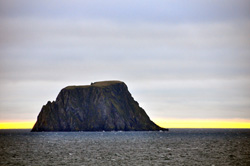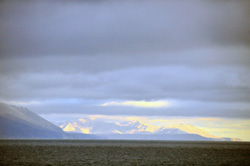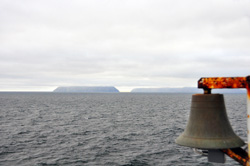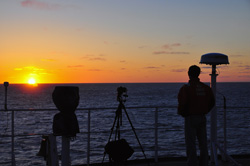We got lucky. We’d been talking about the Bering Strait for a week. Would we arrive there in daylight? Would the fog withdraw for us? It wasn’t a sparkling bright evening, we found after hustling to the bridge, but it was good enough to see Russia. And Alaska. At once. That’s what we wanted. Everyone was up there and excited. Among the many pleasures of this trip and others to the Arctic is the delight everyone takes in observing this special environment. Stepping from port to starboard, from a view of the Old World to the New World, I was thinking about the ways we fix ourselves in time and space, how we accommodate our presence in nature. Dead ahead lay Little Diomede and barely a mile to the west Big Diomede. The former is in the U.S., the latter in Russia. Not only are they split by arbitrary national boundaries, the same line has been designated the International Date Line. It was tomorrow in Russia, while we sailed in today. Both islands, hallowed in cloud, are steep-sided and flat-topped, treeless and by all appearance hostile to human ambition. Yet both are inhabited by indigenous Yup’ik whose forebears were probably fishing and hunting these waters eons before anyone ever identified themselves as Russians or Americans. During the Cold War the natives were prohibited from traveling freely between Big and Little Diomede. Families were split for years by international politics that had flat nothing to do with them While the Yup’ik still pursued something close to the same lifestyle as the first people who crossed the Land Bridge, Peter the Great wanted to know if the Siberian reaches of his nation were connected to North America; so he did what Western monarchs had done since Henry the Navigator in the 1420s—he hired an explorer. He chose a freelancer, the Dutchman Vitus Bering, who, in 1728, sailed through the strait that still bears his name. However, he missed North America in the fog. So it was a geodesist named Gvozdev who became the first European to lay eyes on present Alaska, rounding Point Hope in 1721. The point on the Russian side of the strait is still called Gvozdev. (Cape Prince of Wales forms the east side of the strait.) Twenty years later, Bering tried again to scope out the lay of the land on the Alaskan side of his strait. It’s not clear where exactly he went in Alaska, because the expedition ended tragically. These are still unforgiving waters, but downright lethal in Bering’s day. He was shipwrecked on the return voyage in the Commander Islands, where he died along with 29 others. His naturalist, Georg Steller, survived the wreck, and his name lives on in the Steller’s jay, which, since it’s present only on the North American side, proved that Bering got there, and the Steller’s sea cow, now extinct. The race was on to find a passage from Europe over the top of North America to gain the riches of the east. Northern Europeans had been lusting and searching for it since the reign of Elizabeth, and to give some solidity to wishful thinking, they named it the Strait of Anian. (During the Age of Exploration, naming was synonymous with owing.) Captain Cook, searching for the Passage, was the next to transit Bering Strait, in 1778, at which time northern North America and the Canadian Archipelago were utterly unknown. Cook, never particularly excited about the Northwest Passage, sailed as far as Icy Cape, not far from present Barrow, before turning back. (Records from the Sung dynasty claim that a Buddhist monk, Hwui Shan, sailed up the Kamchatka Peninsula, in a.d. 458, through the Aleutian Islands and into the vicinity of the strait, but no one knows whether to believe it or not.) We transited the strait southbound yesterday evening; our experience was considerably less rigorous than Bering’s. And we had no doubt about where we were, fixed in time and space by the finest electronic gear government money can buy. It glimmered green and orange in multiple, redundant computer screens on the bridge’s 30-foot long control panel. Watch standers kept the ship out of Russian water while we milled around remarking on ocean and land, watching through binoculars, pointing out interesting aspects to each other. “I’m a desperate woman,” Sharon had said up here on the bridge a few days ago while she watched fruitlessly for whales, any marine mammals, for that matter. Brian, who has also spent all day every day on the bridge looking for birds, had not found abundant species or individuals in the Beaufort Sea. That changed not far north of the strait. Puffins, dovekies, little auks, and various ducks began appearing close aboard as we approached the Seward Peninsula’s latitude. Then the whales entered the scene. Humpbacks rolled and “fluked,” raising their tails (flukes) for a deep dive. Grey whales surfaced here and there. They’re easy to identify, we learned from Sharon, because they’re bottom feeders, and when they surface, they leave telltale billows of mud in the water. As Brian, Sharon, and Josh have been pointing out, both the presence and absence of marine mammals and birds are directly related to food-source availability. “Oceans are patchy,” Sharon said. “Some places are rich, others not. The question is how these animals find the rich places.” The Beaufort and Chukchi seas north of Alaska have been under-observed by biologists, while the Bering Sea, known for its richness, has been relatively well documented. One of the things you immediately notice when hanging around with scientists is that they naturally like it when you express interest in their work, but not so much when you ask them why questions. It’s in the nature of the profession to wait until all the data is in before venturing categorical explanations for natural phenomena. None of our biologists has been to the Beaufort or Chukchi before. Now they have, but they’ve only observed those stretches of water within sight of the ship’s track and only at this particular time of year. We civilians, unused to reticence in the face of uncertainty, are impatient for conclusions. Why have they seen relatively few birds/mammals during this trip? The disparity in intellectual approach is particularly pertinent when climate change in the Arctic is the subject. That’s another reason why it’s important to ignore the nonscientists and pseudo-scientists bloviating about climate change as just another natural trend or, worse, as a hoax. Climate and climate change are matters of multidisciplinary science, and only scientists can tell us true things about the mechanics of climate. I for one wish they’d talk about it a bit more publically, but at the same time I understand why they don’t. We hear that a decaying but still formidable typhoon is taking aim at the Aleutian Islands. The bridge guys have been laying on the speed—18 knots—all night to beat the beast to Dutch Harbor. As always with weather we can only wait and see. But we may be seeing a lot of Dutch Harbor instead of flying home. Last updated: September 28, 2010 | |||||||||||||
Copyright ©2007 Woods Hole Oceanographic Institution, All Rights Reserved, Privacy Policy. | |||||||||||||





